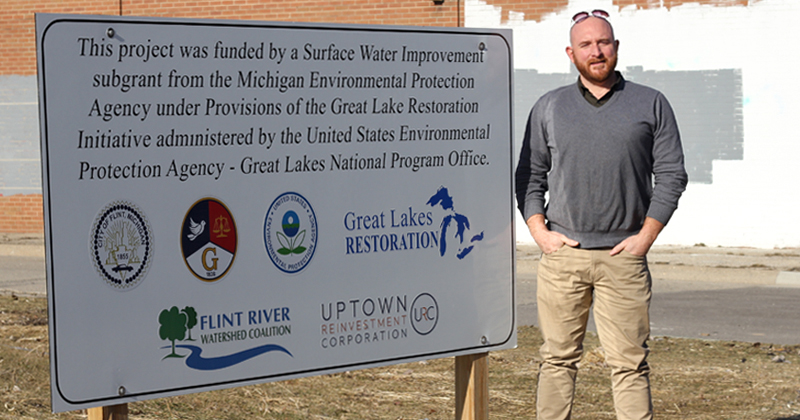
You just became the executive director of the Flint River Watershed Coalition (FRWC). How did you come to this role?
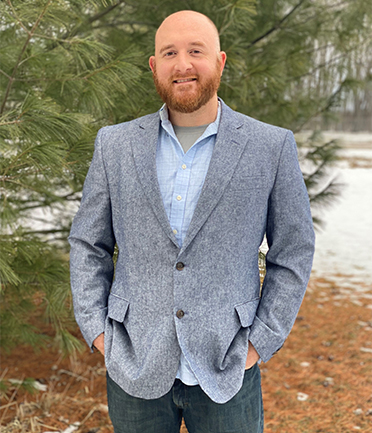
I was first introduced to the Flint River Watershed Coalition when I was in college. While pursuing a degree in wildlife biology at the University of Michigan-Flint, some of the classes helped FRWC volunteers with identifying some of the aquatic insects in the river. I decided to volunteer with the organization after graduation since I enjoyed the projects and events they hosted. Over time, I became a regular site leader for their annual Stewardship Day event at Flushing’s Riverview Park and participated in other fun, annual activities like the Flotilla and the Annual Voice of the River Celebration. In 2019 I was hired at the Genesee Conservation District as the CISMA (Cooperative Invasive Species Management Area) coordinator. In this position, I partnered with the FRWC during guided paddles to show community members the invasive species that inhabit or pose a threat to our watershed.
I’ve lived in the Flint River watershed my entire life and have lived on the Flint River for over a decade. During this time, along with my educational and personal experiences with the river, I furthered this strong passion that I have for the river and all of the wonderful things that are in and around the watershed. I was thrilled at the notion of combining my skills, knowledge, and passion when the potential for the executive director position was announced. I am excited to join this amazing organization and its partners to further protect, promote and improve this beautiful watershed.
What common misconception of the Flint River would you like people to better understand?
I think there is a negative stigma associated with the Flint River where people look at it as being this incredibly dirty and contaminated body of water. Even I was guilty of this at one time. The river has been negatively impacted by human activity for years and it does still bear some of the scars, but the river is much cleaner overall than I feel most people think. It is full of life and has a lot of amazing (and beautiful) wildlife that live in, on, and near the river. Through monitoring events, like the benthic invertebrate monitoring, we are able to paint a great picture of the current state of our river. Benthic invertebrate monitoring is a fancy term for what is essentially pulling the aquatic bugs out of the river and taking a look at what is living there. These critters spend all, or most, of their lives in the river and have varying tolerances to pollution.
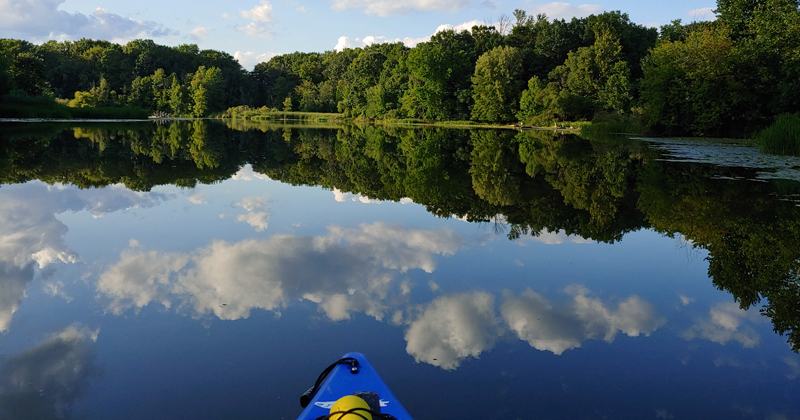
We can determine the health of certain stretches of river based on what and how many bugs we find. Years of data compiled by many passionate and dedicated volunteers demonstrates that the overall health of the river is better than what I suspect most people recognize. We routinely find many insects that are sensitive to pollution, indicating excellent water quality. This includes mayflies, stoneflies, caddisflies, and one of my personal favorites: dobsonflies. The larvae of dobsonflies are called hellgrammites, which are large alien-looking insects that metamorphose into large, fierce-looking, winged adults that look like something from the dinosaur era. If you take the time to get to know the river, you will see that it is home to a vast array of different creatures. The fact that the river can host such diversity shows that the river is in great health and improving. I feel many people may still be avoiding it and talking negatively about it due to misconceptions about its history without recognizing all of the great recreational, social, economic, cultural and aesthetic opportunities it has to offer.
Your organization is called the Flint River Watershed Coalition. What exactly is a watershed?
Everyone lives within a watershed. A watershed can be thought of as a giant funnel. Our state’s natural topography creates these basins that direct all of our precipitation and runoff downhill into an increasingly centralized body of water – in this case, the Flint River. The Flint River watershed drains over 1,300 square miles of land from seven different counties, which is a huge amount of water. Through infrastructure and natural waterways, water from higher grounds is directed to lower elevations, such as creeks and streams that connect with the river. The Flint River then connects with the Shiawassee River entering into the Shiawassee National Wildlife Refuge along with the Bad River and Cass River. The Shiawassee River then connects with the Tittabawassee River to form the Saginaw River, which leads to Saginaw Bay in Lake Huron. Since the entire landscape throughout the watershed is connected, it is imperative that we work together to keep unwanted materials out of this system.
What are your favorite things to do on and around the Flint River?
I enjoy many outdoor recreational activities in and around the Flint River. There are many hiking/biking trails, ample fishing spots, loads of sights for photographers, and many great stretches for canoeing and kayaking. Personally, my favorite thing to do is kayak. When I moved to a spot on the river many years ago, I realized that I had spent a lot of time in and around the river in various capacities throughout my life but had not been taking advantage of the boating opportunity.
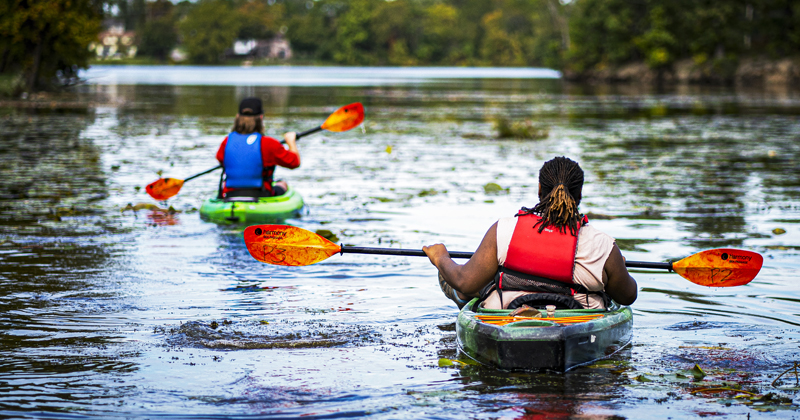
I’ll share this powerful story that mirrors many others’ first experiences paddling the Flint River: In 2010, I purchased some discounted inflatable canoes and prepared for my maiden voyage with some friends. Once we set out on the water, I was instantly amazed. I felt like I had stepped into a different world that had been patiently waiting for me to find it. The feeling of the water pushing back on you as your weight settles in the canoe was a bit unnerving, and it took a few practice strokes, but quickly we got the hang of it and were on our way. There were dragonflies buzzing around eating smaller insects and birds on nearby branches waiting to snag the dragonflies. Fish were jumping, turtles were sunbathing, and eventually, we spotted the star of the show – a giant bald eagle feeding off of a freshly caught fish. The river was, and is, abound with life. We stopped at a small island roughly halfway through our trip and were quickly reminded that we were not far from the influence of human activity. The island was littered with trash. We picked up cans, bottles, and other random refuse. I found pieces of old bottles in various shades of green, blue, brown, and cloudy white – all smoothed over by years of tumbling along in the river. It has become a tradition that with each trip I stop here and collect a new handful of these pieces. Subsequent trips only further fostered my newfound love and appreciation for this beautiful system. I love taking people out for the first time and seeing the look on their faces. I see it and I know exactly what they are feeling because I felt it too on my first time out. With each passing year, the landscape slowly changes, but many things still remain the same. I know the best spot to spy the timid softshell turtle while sunbathing; the dead ash tree where the bald eagle likes to perch; and where the deer like to cross the river. Sadly, litter is almost always present and some invasive species, like Japanese knotweed are spreading along the shore. This can change.
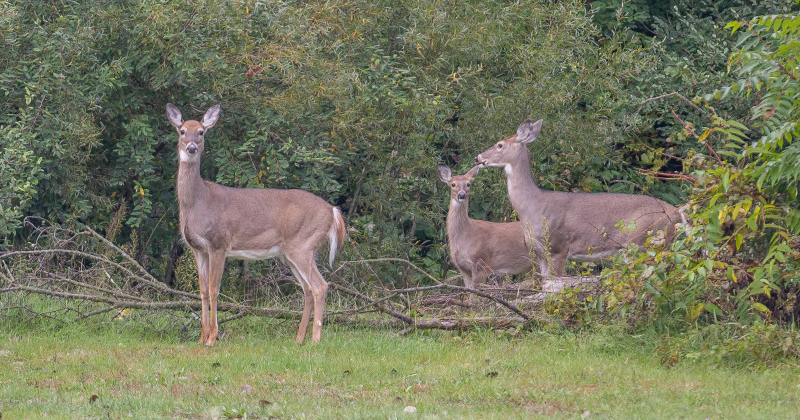
As we introduce more and more people to the Flint River, it is our hope that, like me, they will want to work to protect and improve it. The Flint River is a constant in my life that has given me far more than I could ever hope to give it in return. If while reading this you realize that you have not had the pleasure of having this experience, I encourage you to put it on your list of things to do this year. Join the FRWC on a guided paddle or rent kayaks from Kayak Flint. We are eager to help you get better acquainted with this old friend.
What are your hopes for the future of the Flint River Watershed Coalition (FRWC) and its programs?
My hope for the future of the FRWC is to further our mission to promote, protect, and improve the Flint River and the associated watershed. I want the community to discover for themselves that the river is not as unhealthy as it is often perceived. I want to work with the community to understand where these perceptions are coming from and how we can partner to change this narrative. I want to provide educational and volunteer opportunities to those who want to find out more or get involved. We will continue to pursue funding to create or improve upon our recently expanded programs and projects that will further enhance the condition of the river and increase the community’s ability to use and enjoy it.

We would like to see a broader community get involved in our mission to protect, promote and improve the Flint River watershed. We have volunteer events, such as cleanup events, stewardship projects and our twice a year benthic invertebrate monitoring. We have an excellent education program, which aims to empower youth as stewards of our water resources through scientific investigations and community engagement. Local youth are asking questions and taking action to minimize human impacts and further protect the river. Our Kayak Flint livery and guided paddle programs are great ways to explore the river while supporting the FRWC in the work we do to protect the river and its watershed. We have a number of fundraising events throughout the year which are fun ways to network in a relaxed and entertaining setting.
Ultimately, I hope to instill the same love that we have for the Flint River in the many people that live, work and recreate throughout our beautiful watershed because the best way to protect the river is to show everyone that it is worth protecting.
